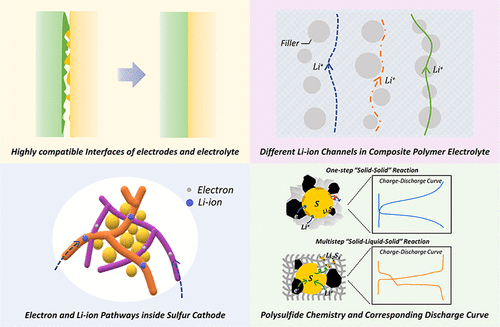当前位置:
X-MOL 学术
›
Energy Fuels
›
论文详情
Our official English website, www.x-mol.net, welcomes your
feedback! (Note: you will need to create a separate account there.)
A Review of Solid-State Lithium–Sulfur Battery: Ion Transport and Polysulfide Chemistry
Energy & Fuels ( IF 5.2 ) Pub Date : 2020-09-03 , DOI: 10.1021/acs.energyfuels.0c02647 Hui Pan 1 , Zhu Cheng 1 , Ping He 1 , Haoshen Zhou 1, 2
Energy & Fuels ( IF 5.2 ) Pub Date : 2020-09-03 , DOI: 10.1021/acs.energyfuels.0c02647 Hui Pan 1 , Zhu Cheng 1 , Ping He 1 , Haoshen Zhou 1, 2
Affiliation

|
The lithium–sulfur (Li–S) battery has long been a research hotspot due to its high theoretical specific capacity, low cost, and nontoxicity. However, there are still some challenges impeding the Li–S battery from practical application, such as the shuttle effect of lithium-polysulfides (LiPSs), the growth of lithium dendritic, and the potential leakage risk of liquid electrolytes. Substitution of liquid electrolytes with solid-state electrolytes (SSEs) is an effective strategy to relieve or even solve these problems. This review focuses on the most crucial issues of the solid-state Li–S battery (SSLSB) and exhibits the recent progress in these fields. SSEs applicable in the Li–S battery including inorganic glassy ceramics and ceramics, organic polymers, and inorganic–organic hybrid electrolytes are reviewed. Then, the establishment of Li-ion pathways inside the cathode is discussed in detail. We also probe into the unique polysulfide chemistry of the Li–S battery and expound our opinions. Finally, conclusions and perspectives are outlined for the further development of SSLSBs.
中文翻译:

固态锂硫电池综述:离子迁移和多硫化物化学
锂硫(Li–S)电池由于其较高的理论比容量,低成本和无毒性,一直是研究的热点。但是,仍然存在一些阻碍锂锂电池实际应用的挑战,例如多硫化锂(LiPSs)的穿梭效应,树枝状锂的生长以及液体电解质的潜在泄漏风险。用固态电解质(SSE)代替液态电解质是缓解甚至解决这些问题的有效策略。这篇评论集中在固态锂电池(SSLSB)的最关键问题上,并展示了这些领域的最新进展。审查了适用于Li-S电池的SSE,包括无机玻璃陶瓷和陶瓷,有机聚合物以及无机-有机混合电解质。然后,详细讨论了阴极内部锂离子通道的建立。我们还探讨了Li-S电池独特的多硫化物化学性质,并阐明了我们的观点。最后,总结和总结了SSLSB的进一步发展。
更新日期:2020-10-16
中文翻译:

固态锂硫电池综述:离子迁移和多硫化物化学
锂硫(Li–S)电池由于其较高的理论比容量,低成本和无毒性,一直是研究的热点。但是,仍然存在一些阻碍锂锂电池实际应用的挑战,例如多硫化锂(LiPSs)的穿梭效应,树枝状锂的生长以及液体电解质的潜在泄漏风险。用固态电解质(SSE)代替液态电解质是缓解甚至解决这些问题的有效策略。这篇评论集中在固态锂电池(SSLSB)的最关键问题上,并展示了这些领域的最新进展。审查了适用于Li-S电池的SSE,包括无机玻璃陶瓷和陶瓷,有机聚合物以及无机-有机混合电解质。然后,详细讨论了阴极内部锂离子通道的建立。我们还探讨了Li-S电池独特的多硫化物化学性质,并阐明了我们的观点。最后,总结和总结了SSLSB的进一步发展。











































 京公网安备 11010802027423号
京公网安备 11010802027423号